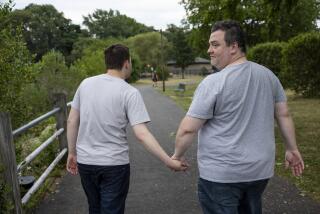Knowing in months, not years
- Share via
Child development experts may one day be able to identify children at risk for autism before their first birthdays.
Researchers are beginning to study infants who are the younger siblings of autistic children. Earlier studies have shown that when one child in a family has autism, the risk of the disorder in a younger sibling increases by an estimated 10% to 20%.
At the UC Irvine clinic For OC Kids, Dr. Pauline Filipek says she routinely asks parents with an autistic child to bring younger siblings to appointments at the clinic so she can observe the siblings for symptoms.
Even infants as young as 6 months can be screened for potential warning signs, some experts say. For example, while all 6-month-olds like to gaze at objects that interest them, autistic babies may focus solely, and repeatedly, on a single object; their parents may have difficulty redirecting their attention.
Also, 6-month-olds ordinarily enjoy gazing at faces, especially their parents’, Filipek says. Autistic babies, however, often avoid eye contact.
“When you hold a newborn or a 2-month-old, that baby is mesmerized by your face,” she says. “That baby can stare at your face and will stick his tongue out at you and imitate you. They coo. By age 4 or 5 months, you should be able to have a ‘conversation’ with that baby.”
Autism appears to involve problems reading and decoding information from a person’s face, says Geraldine Dawson, director of the Autism Center at the University of Washington’s Center on Human Development and Disability. In one study of 3-year-olds, Dawson monitored the brain activity of children as they were shown pictures of their mothers and of strangers. The autistic children showed no reaction to their mothers’ faces as compared with strangers’ faces.
“Face recognition is one area we’re very interested in,” she says. “These are behaviors we should be able to pick up on very early.”
Researchers also are looking at how babies respond to speech. Babies seem to prefer listening to their mothers’ speech more than nonspeech sounds. An autistic child, however, may not show such a preference. “We may not be able to diagnose autism with this, but we could pick up a child at risk,” says Dawson, who is conducting a study on early speech recognition.
Experts caution that more research is needed before doctors can reliably diagnose autism in infants or babies. Today, most children with autism are evaluated using diagnostic instruments designed for 3- or 4-year-olds. There are no standard criteria for diagnosing the disorder in children ages 1 or 2.
Experienced autism researchers can usually determine whether a 2-year-old child is on the “autism spectrum,” but they can’t predict the severity of the disorder, says Dawson. Besides the wide variation in severity, children with autism can differ in many ways. Some are mentally retarded or have feeding problems or poor muscle tone, while others lack these characteristics.






